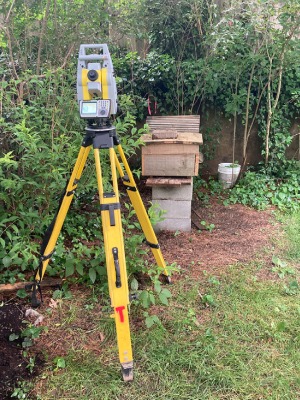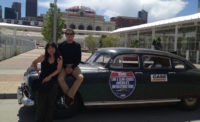This year has found me several times in the company of bees, lots of bees, hundreds of bees and thousands of bees. For land surveyors, interactions eventually bring us face to face with nature in unexpected ways. This is an aspect of the profession that brings joy to my life and occasionally fear, and sometimes it might make me run.
In spring, I was performing field work to prepare an as-built survey plan in order to prove to the township that the owner had kept to the design plan. My eyes are always looking for the many items I will want to show on my plan. At this particular property, I was standing on their new rear flagstone patio and heard a machine of some sort and I could not connect the sound with any of my memories. The first choice was pool equipment doing something odd, but this lot had no pool. Then I imagined a huge fan running on the next level down and it must be out of sight. Walking around to where I thought the noise was produced, it was obvious there was nothing there. Then I stood and listened and looked up.
Above me, starting about ten feet off the ground, was the bottom of a giant swarm of honeybees filling the leaves. It was magical. Since I’d experienced a swarm moving through our back yard 30 years ago, I felt I probably had nothing to fear, they were busy bees looking for a new home. Perhaps 15 feet away a hollow tulip poplar tree had bees coming out a huge hole and ascending up into the air. I watched for five minutes and went back to work thinking to warn the client in case they were allergic to bee stings but no one was home. In a half hour there was not a bee left on the tree of in the yard. They had all moved to better pastures. I was glad to be there at that time and witness the event.
 The brother-in-law of a fellow who had worked where we both were employed at the time, told a story of being dropped off with a crew and equipment on a mountain top in Alaska. The helicopter was rising and then suddenly dropped back down and the pilot frantically waving them back into the chopper. As the aircraft had first ascended, his eyes fell onto a bear running straight up the hillside to where the survey crew had just got out. Apparently, the party chief was armed with a pistol, but had the pilot not been so responsible to observe the surrounding land, the bear might have found the crew chief before he found his gun. That was back in the 70’s and they were running long control lines. You can see so far from a mountaintop.
The brother-in-law of a fellow who had worked where we both were employed at the time, told a story of being dropped off with a crew and equipment on a mountain top in Alaska. The helicopter was rising and then suddenly dropped back down and the pilot frantically waving them back into the chopper. As the aircraft had first ascended, his eyes fell onto a bear running straight up the hillside to where the survey crew had just got out. Apparently, the party chief was armed with a pistol, but had the pilot not been so responsible to observe the surrounding land, the bear might have found the crew chief before he found his gun. That was back in the 70’s and they were running long control lines. You can see so far from a mountaintop.
My Missouri coworkers recalled with laughter, how one of the rodmen was told to go give a backsight and failed in his mission. They looked to see where he went and saw his head and he was just over a hill. As they walked toward him they observed he was standing on a wooden fencepost poking at something with one of those old red and white, screw-together range poles. Getting closer, it was a skunk trying to climb the post to get to him and it was broad daylight. Fence posts make for short trees in which to escape and all he could do was keep pushing it back down. The poor little stinker was sick with rabies, and it was not long before someone with a gun was brought to the scene to rescue the rodman.
We surveyors are so blessed to have such opportunities. Sometimes it does not seem so, but generally we are. I do not play golf, but I love to prepare boundary and topographic surveys for golf courses. Following many motorcycle crashes I would never participate in after school sports, but I have staked out and as-built many athletic fields and buildings. I am not trained in animal husbandry, but I sure loved the times I’ve surveyed within the Philadelphia Zoo and proud of the work and topographic survey plans we made there.
On one project, the architects wanted to know the shape of the bottom of very large duck pond and two of us, me being one, wore the highest chest waders I could purchase and walked the bottom taking readings with only inches to spare some of the time. They wanted to put a liner in what was probably an acre pond that had too many water foul if you follow my drift. It reminds me of the punchline of a joke I can’t tell but the people were all chanting “Don’t make waves.” When things got too pungent the city would just open an 8” water main and flush the pond out. The city owned the water company and so ignored the expense. They would eventually put in a filtering system.
Surveyors opened the westward expansion. Mapped the rivers, lakes, and created all those square properties starting with Ohio and Westward Ho! The section system of the Midwest I encountered was pretty tame, but the first surveyors must have had quite a rugged life. There's still plenty of adventure to be had. I think this profession has a draw for many once they get a taste for it.
We all must be cautious still of the dangers of the work. They can be from animals, rivers, cliffs, cave-ins, snakes, bears, bugs, and perhaps the worst of all, people, or worse than that, people driving cars. My crew was sent out to survey a part of a very large estate. I drove the van up a long curving drive though an open pasture-like area and pulled off to the side and parked. While we were getting out the equipment a station wagon full of men pulled up and they exited with shot guns and chambering shells with one of them demanding what we thought we were doing there. I answered, “We are here to survey this property.”
That leader said “ok,” and with-out another word, they all returned to their vehicle and drove back up driveway. We looked at each other stunned. It would be ten years before I understood the identity of the leader after he was found unstable and had killed a man. Generally, I do enjoy working for the wealthy. They pay their bills and have nice properties.
The various places to be surveyed keep me in love with the profession. I once had a retired engineer come out to shoot the breeze with me. He said he wished he had gone into land surveying. After college he went to work for a large engineering and architectural firm. He was so good at designing pipe racks that he became ‘the pipe rack guy’ and spent his whole career designing pipe racks and had become burnt out. His experience was not broad because he was just so good at what he did. I’ve seen this with large civil engineering companies where a person might be ‘the stormwater guy.’ When I see movies and pipe racks in the scenes, the memory of this conversation will come to mind.
I have been spoiled in that I have not often ended up stuck on long term construction projects. There are many great surveyors I’ve known who spend a year or two on one large stakeout site. I am happy to keep out of the mud and away from the risk of contractors trying to shift blame to anyone to keep themselves out of trouble. However, to survey from the top of a 40 story building roof, well, that can be breathtaking and I have a lot of respect for the layout people that bring those towers up from the ground. That seems like risky business.
My personal high-rise story was of my crew being assigned the project to survey two high rise buildings in Philadelphia on the ground and from the rooftops. Our client rented out the roof of the building for microwave radio-relay towers aimed miles away. The problem was, the neighboring building was going to construct something on their roof and the question was, would it obstruct the view from the relay tower on the roof of our project building up to Valley Forge Mountain? We signed papers holding the building owners harmless if something happened to us. I asked our survey director what that was all about, and he said it’s possible one of us might take the ‘big step’ or simply fall off. The world is very different from the height of William Penn’s hat brim. It was strangely quiet. Looking off the parapet, I watched the window washers swipe suds off windows and it floated down like clouds but evaporated before it hit the pedestrians below. If you want to be asked to perform those surveys, be sure you do not complain when assigned hard projects. My first party chief taught me that.
With the now common survey robots, it can leave a person, like me, working alone in what could be dangerous situations. An engineer asked me to survey up a large culvert that flowed under the project we had been working on. There were no maps of what started out as a stream, then a stream with stone walls, then a stream with varying types of roofs such as arches, flat, or eventually big concrete pipes and all long buried. A deep sanitary line was to be crossing the culvert and one question was would it collide with the culvert? A second question was, would the hotel to be constructed possibly rest on the culvert?
The contractor set up and very tall ladder and fastened it to railroad ironwork for me to descend to the Schuylkill River below. I put a control point out on a railroad bridge and from that point set a drill hole in the concrete of the apron of the large culvert. I lowered my equipment by rope and then climbed the ladder down to the apron. I am afraid of heights, but you have to do what you have to do, and I knew the contractor and his men had been up and down the ladder and it held. Setting my robot up on the drill hole I began to traverse up the culvert, locating the angles, thread of the stream, top of walls, and top of arches until the pipe was only 36 inches and I could go no further. At one point, I had to disassemble part of the instrument legs to set up and turn the angle up the pipe. I used manhole shafts above and inlets to check my work, and most importantly, I kept tabs on the weather. Should a thunderstorm pop up it might end up raining cats and dogs, and surveyors.
Getting back to the bees, my second run in with honeybees was last week and the hive boxes are shown in the photo. While working on an urban topographic survey, and having little luck in finding the rear lot corners due to the depth of debris, mulch, limbs, etc…. I had a neighbor graciously allow me to look for corners in his back yard. Seeing pink flagging laying on the ground I correctly guessed there was a pin at the bottom of a five-foot-high retaining wall. Hindering me from approaching that flagging was the neighbor’s beehives, and the hundreds of bees going in and out along their ‘bee line’ and then the bees that buzz around the front of the hives.
I asked the owner if I were to walk behind the hives, would I be safe. He told me he thought so, but do not get in the way of their bee line or I would be in trouble. I set a nail near the hives but on the side. Then I placed a piece of wood on top of the pin so I could find it easily. With a few stems snapped, I had my shot and something to work with when I start my calculations. Had I not had the owner right there to ask about bee safety, I probably would have tried it anyway. The bees are busy and have no time at all for careful surveyors locating pins. Had I tripped and bumped their box, this story would have had a very different ending.
There still is a lot of adventure in land surveying. It will not happen all in one day or one year, but I feel we land surveyors are blessed in our profession and our skill, wisdom and expertise will always be required and in the meantime, we are all paid to measure the world.
This article was originally posted on www.pobonline.com.




Post a comment to this article
Report Abusive Comment